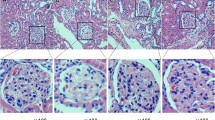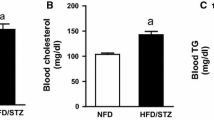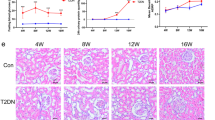Abstract
Background
The aim of this study is to investigate the renoprotective effect of the GLP-1 receptor agonist, liraglutide, in early-phase diabetic kidney disease (DKD) using an animal model of type 2 diabetes with several metabolic disorders.
Methods
Male 8-week-old spontaneously diabetic Torii (SDT) fatty rats (n = 19) were randomly assigned to three groups. The liraglutide group (n = 6) was injected subcutaneously with liraglutide. Another treatment group (n = 6) received subcutaneous insulin against hyperglycemia and hydralazine against hypertension for matching blood glucose levels and blood pressure with the liraglutide group. The control groups of SDT fatty (n = 7) and non-diabetic Sprague–Dawley rats (n = 7) were injected only with a vehicle.
Results
The control group of SDT fatty rats exhibited hyperglycemia, obesity, hypertension, hyperlipidemia, glomerular sclerosis, and tubulointerstitial injury with high urinary albumin and L-FABP levels. Liraglutide treatment reduced body weight, food intake, blood glucose and blood pressure levels, as well as ameliorated renal pathologic findings with lower urinary albumin and L-FABP levels. Liraglutide increased expressions of phosphorylated (p)-eNOS and p-AMPK in glomeruli, downregulated renal expression of p-mTOR, and increased renal expressions of LC3B-II, suggesting activation of autophagy. However, these effects were not caused by the treatments with insulin and hydralazine, despite comparable levels of hyperglycemia and hypertension to those achieved with liraglutide treatment.
Conclusions
Liraglutide may exert a renoprotective effect via prevention of glomerular endothelial abnormality and preservation of autophagy in early-phase DKD, independent of blood glucose, and blood pressure levels.







Similar content being viewed by others
Data availability
The data used to support the findings of this study are included within the article.
References
Yin WL, Bain SC, Min T. The effect of glucagon-like peptide-1 receptor agonists on renal outcomes in type 2 diabetes. Diabetes Ther. 2020;11(4):835–44.
Hviid AVR, Sørensen CM. Glucagon-like peptide-1 receptors in the kidney: impact on renal autoregulation. Am J Physiol Renal Physiol. 2020;318(2):F443–54.
Fujita H, Morii T, Fujishima H, Sato T, Shimizu T, Hosoba M, et al. The protective roles of GLP-1R signaling in diabetic nephropathy: possible mechanism and therapeutic potential. Kidney Int. 2014;85(3):579–89.
Pfeffer MA, Claggett B, Diaz R, Dickstein K, Gerstein HC, Køber LV, et al. Lixisenatide in patients with type 2 diabetes and acute coronary syndrome. N Engl J Med. 2015;373(23):2247–57.
Tuttle KR, Lakshmanan MC, Rayner B, Busch RS, Zimmermann AG, Woodward DB, et al. Dulaglutide versus insulin glargine in patients with type 2 diabetes and moderate-to-severe chronic kidney disease (AWARD-7): a multicentre, open-label, randomised trial. Lancet Diabetes Endocrinol. 2018;6(8):605–17.
Mosenzon O, Blicher TM, Rosenlund S, Eriksson JW, Heller S, Hels OH, et al. Efficacy and safety of oral semaglutide in patients with type 2 diabetes and moderate renal impairment (PIONEER 5): a placebo-controlled, randomised, phase 3a trial. Lancet Diabetes Endocrinol. 2019;7(7):515–27.
Davies MJ, Bain SC, Atkin SL, Rossing P, Scott D, Shamkhalova MS, et al. Efficacy and safety of liraglutide versus placebo as add-on to glucose-lowering therapy in patients with type 2 diabetes and moderate renal impairment (LIRA-RENAL): a randomized clinical trial. Diabetes Care. 2016;39(2):222–30.
Jensen EP, Møller S, Hviid AV, Veedfald S, Holst JJ, Pedersen J, et al. GLP-1-induced renal vasodilation in rodents depends exclusively on the known GLP-1 receptor and is lost in prehypertensive rats. Am J Physiol Renal Physiol. 2020;318(6):F1409–17.
Xue L, Pan Z, Yin Q, Zhang P, Zhang J, Qi W. Liraglutide promotes autophagy by regulating the AMPK/mTOR pathway in a rat remnant kidney model of chronic renal failure. Int Urol Nephrol. 2019;51(12):2305–13.
Muskiet MHA, Tonneijck L, Smits MM, van Baar MJB, Kramer MHH, Hoorn EJ, et al. GLP-1 and the kidney: from physiology to pharmacology and outcomes in diabetes. Nat Rev Nephrol. 2017;13(10):605–28.
Matsui K, Ohta T, Oda T, Sasase T, Ueda N, Miyajima K, et al. Diabetes-associated complications in Spontaneously Diabetic Torii fatty rats. Exp Anim. 2008;57(2):111–21.
Tanabe J, Ogura Y, Nakabayashi M, Nagai Y, Watanabe S, Sugaya T, et al. The possibility of urinary liver-type fatty acid-binding protein as a biomarker of renal hypoxia in spontaneously diabetic torii fatty rats. Kidney Blood Press Res. 2019;44(6):1476–92.
Tomohiro T, Kumai T, Sato T, Takeba Y, Kobayashi S, Kimura K. Hypertension aggravates glomerular dysfunction with oxidative stress in a rat model of diabetic nephropathy. Life Sci. 2007;80(15):1364–72.
Mima A, Hiraoka-Yamomoto J, Li Q, Kitada M, Li C, Geraldes P, et al. Protective effects of GLP-1 on glomerular endothelium and its inhibition by PKCβ activation in diabetes. Diabetes. 2012;61(11):2967–79.
Thomson SC, Kashkouli A, Liu ZZ, Singh P. Renal hemodynamic effects of glucagon-like peptide-1 agonist are mediated by nitric oxide but not prostaglandin. Am J Physiol Renal Physiol. 2017;313(4):F854–8.
Zhou SJ, Bai L, Lv L, Chen R, Li CJ, Liu XY, et al. Liraglutide ameliorates renal injury in streptozotocin-induced diabetic rats by activating endothelial nitric oxide synthase activity via the downregulation of the nuclear factor-κB pathway. Mol Med Rep. 2014;10(5):2587–94.
Mohan S, Reddick RL, Musi N, Horn DA, Yan B, Prihoda TJ, et al. Diabetic eNOS knockout mice develop distinct macro- and microvascular complications. Lab Invest. 2008;88(5):515–28.
Kitada M, Ogura Y, Monno I, Koya D. Regulating autophagy as a therapeutic target for diabetic nephropathy. Curr Diab Rep. 2017;17(7):53.
Klionsky DJ, Abdelmohsen K, Abe A, Abedin MJ, Abeliovich H, Acevedo Arozena A et al (2016) Guidelines for the use and interpretation of assays for monitoring autophagy (3rd edition). Autophagy 12(1):1–222.
Lambers Heerspink HJ, Gansevoort RT. Albuminuria is an appropriate therapeutic target in patients with CKD: the pro view. Clin J Am Soc Nephrol. 2015;10(6):1079–88.
Park CW, Kim HW, Ko SH, Lim JH, Ryu GR, Chung HW, et al. Long-term treatment of glucagon-like peptide-1 analog exendin-4 ameliorates diabetic nephropathy through improving metabolic anomalies in db/db mice. J Am Soc Nephrol. 2007;18(4):1227–38.
Sukumaran V, Tsuchimochi H, Sonobe T, Shirai M, Pearson JT. Liraglutide improves renal endothelial function in obese Zucker rats on a high-salt diet. J Pharmacol Exp Ther. 2019;369(3):375–88.
Yamamoto T, Takabatake Y, Takahashi A, Kimura T, Namba T, Matsuda J, et al. High-fat diet-induced lysosomal dysfunction and impaired autophagic flux contribute to lipotoxicity in the kidney. J Am Soc Nephrol. 2017;28(5):1534–51.
Acknowledgments
We thank Ms. Kimie Katayama (Division of Nephrology and Hypertension, Department of Internal Medicine, St. Marianna University School of Medicine), Ms. Junko Asano (Department of Internal Medicine, St. Marianna University School of Medicine), Ms. Naomi Saito and Ms. Michiyo Ohashi (Department of Anatomy, St. Marianna University School of Medicine), for great technical assistance.
Funding
This study was supported by JSPS KAKENHI Grant Number JP 19K11478.
Author information
Authors and Affiliations
Contributions
SY, JT, YO, TS, KO, and AK-I study design. SY, JT, YO, KK, KO, SW, KI, SH, and AK-I data collection. SY and AK-I data analysis. SY, YO, YN, DI, TS, KO, KK, YS, and AK-I data interpretation. SY and AK-I literature search and figure generation and SY, YO, and AK-I writing of the manuscript. All authors approved the final version of the manuscript for publication.
Corresponding author
Ethics declarations
Conflict of interest
TS is the Director and a senior scientist at CMIC Holdings Co., Ltd., and KO is a scientist at CMIC Holdings Co., Ltd., which produced the kits for L-FABP analysis. All other authors declare no conflicts of interest.
Additional information
Publisher's Note
Springer Nature remains neutral with regard to jurisdictional claims in published maps and institutional affiliations.
Supplementary Information
Below is the link to the electronic supplementary material.
About this article
Cite this article
Yamada, S., Tanabe, J., Ogura, Y. et al. Renoprotective effect of GLP-1 receptor agonist, liraglutide, in early-phase diabetic kidney disease in spontaneously diabetic Torii fatty rats. Clin Exp Nephrol 25, 365–375 (2021). https://doi.org/10.1007/s10157-020-02007-2
Received:
Accepted:
Published:
Issue Date:
DOI: https://doi.org/10.1007/s10157-020-02007-2




